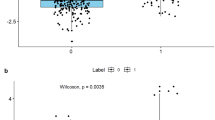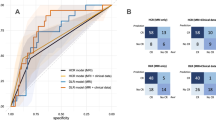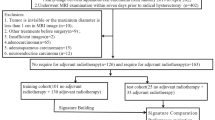Abstract
Purpose
To establish and validate a deep learning radiomics nomogram (DLRN) based on intratumoral and peritumoral regions of MR images and clinical characteristics to predict recurrence risk factors in early-stage cervical cancer and to clarify whether DLRN could be applied for risk stratification.
Methods
Two hundred and twenty five pathologically confirmed early-stage cervical cancers were enrolled and made up the training cohort and internal validation cohort, and 40 patients from another center were enrolled into the external validation cohort. On the basis of region of interest (ROI) of intratumoral and different peritumoral regions, two sets of features representing deep learning and handcrafted radiomics features were created using combined images of T2-weighted MRI (T2WI) and diffusion-weighted imaging (DWI). The signature subset with the best discriminant features was chosen, and deep learning and handcrafted signatures were created using logistic regression. Integrated with independent clinical factors, a DLRN was built. The discrimination and calibration of DLNR were applied to assess its therapeutic utility.
Results
The DLRN demonstrated satisfactory performance for predicting recurrence risk factors, with AUCs of 0.944 (95% confidence interval 0.896–0.992) and 0.885 (95% confidence interval 0.834–0.937) in the internal and external validation cohorts. Furthermore, decision curve analysis revealed that the DLRN outperformed the clinical model, deep learning signature, and radiomics signature in terms of net benefit.
Conclusion
A DLRN based on intratumoral and peritumoral regions had the potential to predict and stratify recurrence risk factors for early-stage cervical cancers and enhance the value of individualized precision treatment.






Similar content being viewed by others
Abbreviations
- DLRN:
-
Deep learning radiomics nomogram
- ROI:
-
Region of interest
- T2WI:
-
T2-weighted MRI
- DWI:
-
Diffusion-weighted imaging
- LNM:
-
Lymph node metastasis
- PMI:
-
Parametrial invasion
- LVSI:
-
Lymphovascular space invasion
- AUC:
-
Area under curve
- DL:
-
Deep learning
- CNN:
-
Convolutional neural network
- ICC:
-
Intraclass correlation coefficient
- DCA:
-
Decision curve analysis
- SCC-Ag:
-
Squamous cell carcinoma antigen
- LASSO:
-
Least absolute shrinkage and selection operator
- ROC:
-
Receiver operating characteristic
References
Sung H, Ferlay J, Siegel RL, et al. (2021) Global cancer statistics 2020: GLOBOCAN estimates of incidence and mortality worldwide for 36 cancers in 185 countries. CA Cancer J Clin 71:241-249. https://doi.org/10.3322/caac.21660
Scharl S, Becher C, Gerken M, et al. (2021) Is there a benefit for adjuvant radio(chemo)therapy in early cervical cancer? Results from a population-based study. Arch Gynecol Obstet 304(3):759–771. https://doi.org/10.1007/s00404-021-05989-w
Greggi S, Scaffa C. (2012) Surgical management of early cervical cancer: the shape of future studies. Curr Oncol Rep 14: 527-34.
Bhatla N, Aoki D, Sharma DN, et al. (2018) Cancer of the cervix uteri. Int J Gynaecol Obstet 143(2):22-36. https://doi.org/10.1002/ijgo.12611
Abu-Rustum NR, Yashar CM, Bean S, et al. (2020) NCCN Guidelines Insights: Cervical Cancer, Version 1.2020. J Natl Compr Canc Netw 18:660-666. https://doi.org/10.6004/jnccn.2020.0027.
Sedlis A, Bundy BN, Rotman MZ, et al. (1999) A randomized trial of pelvic radiation therapy versus no further therapy in selected patients with stage IB carcinoma of the cervix after radical hysterectomy and pelvic lymphadenectomy: A Gynecologic Oncology Group Study. Gynecol Oncol 73:177. https://doi.org/10.1006/gyno.1999.5387
Wu G, Jochems A, Refaee T, et al. (2021) Structural and functional radiomics for lung cancer. Eur J Nucl Med Mol Imaging 48(12):3961-3974. https://doi.org/10.1007/s00259-021-05242-1.
Lambin P, Leijenaar RTH, Deist TM, et al. (2017) Radiomics: the bridge between medical imaging and personalized medicine. Nat Rev Clin Oncol 14:749-762. https://doi.org/10.1038/nrclinonc.2017.141
Xiao ML, Ma FH, Li YG, et al. (2020) Multiparametric MRI-based radiomics nomogram for predicting lymph node metastasis in early-stage cervical cancer. J Magn Reason Imaging ; 52:885-896. https://doi.org/10.1002/jmri.27101
Wang T, Gao T, Guo H, et al. (2020) Preoperative prediction of parametrial invasion in early-stage cervical cancer with MRI-based radiomics nomogram. Eur Radiol 30:3585-359. https://doi.org/10.1007/s00330-019-06655-1
Li Z, Li H, Wang S, et al. (2019) MR-based radiomics nomogram of cervical cancer in prediction of the lymph-vascular space invasion preoperatively: preoperative prediction of LVSI. J Magn Reason Imaging 49(5):1420-1426. https://doi.org/10.1002/jmri.26531
Deng X, Liu M, Sun J, et al. (2021) Feasibility of MRI-based radiomics features for predicting lymph node metastases and VEGF expression in cervical cancer. Eur J Radiol 134:109429. https://doi.org/10.1016/j.ejrad.2020.109429
Li XX, Lin TT, Liu B, et al. (2020) Diagnosis of cervical cancer with parametrial invasion on whole-tumor dynamic contrast-enhanced magnetic resonance imaging combined with whole-lesion texture analysis based on T2- weighted images. Front Bioeng Biotech 8:590. https://doi.org/10.3389/fbioe.2020.00590
Ma C , Zhang Y , Li R , et al. (2013) Risk of parametrial invasion in women with early stage cervical cancer: a meta-analysis. Arch Gynecol Obstet 297:573-580. https://doi.org/10.1007/s00404-017-4597-0
Du R, Li L, Ma S, et al. (2018) Lymph nodes metastasis in cervical cancer: Incidences, risk factors, consequences and imaging evaluations. Asia Pac J Clin Oncol 14:e380-e385. https://doi.org/10.1111/ajco.12997.
P Benedetti‐Panici, Maneschi F, DAndrea G, et al. (2000) Early cervical carcinoma: The natural history of lymph node involvement redefined on the basis of thorough parametrectomy and giant section study. Cancer 88:2267-2274. https://doi.org/10.1002/(sici)1097-0142(20000515)88:10<2267::aid-cncr10>3.0.co;2-9
Dabi Y, Willecocq C, Ballester M, et al. (2018) Identification of a low risk population for parametrial invasion in patients with early-stage cervical cancer. J Transl Med 16:163. https://doi.org/10.1186/s12967-018-1531-6
Chartrand G, Cheng P, Vorontsov E, et al. (2017) Deep learning: a primer for radiologists. Radiographics 37:2113–2131. https://doi.org/10.1148/rg.2017170077
Philbrick K, Yoshida K, Inoue D, et al. (2018) What does deep learning see? Insights from a classififier trained to predict contrast enhancement phase from CT images. Am J Roentgenol 211:1184-1193. https://doi.org/10.2214/AJR.18.20331
Wang S, Zhou M, Liu Z, et al. (2017) Central focused convolutional neural networks: developing a data-driven model for lung nodule segmentation. Med Image Anal 40:172–183. https://doi.org/10.1016/j.media.2017. 06.014
Lustberg T, van Soest J, Gooding M, et al. (2018) Clinical evaluation of atlas and deep learning based automatic contouring for lung cancer. Radiother Oncol 126:312–317. https://doi.org/10.1016/j.radonc.2017.11.012
Liu X, Zhang D, Liu Z, et al. (2021) Deep learning radiomics-based prediction of distant metastasis in patients with locally advanced rectal cancer after neoadjuvant chemoradiotherapy: a multicentre study. EBioMedicine 69:103442. https://doi.org/10.1016/j.ebiom.2021.103442
Peng H, Dong D, Fang MJ, et al. (2019) Prognostic value of deep learning PET/CT-based radiomics: potential role for future individual induction chemotherapy in advanced nasopharyngeal carcinoma. Clin Cancer Res 25:4271–4279. https://doi.org/10.1158/1078-0432.CCR-18-3065
Hu Y, Xie C, Yang H, et al. (2021) Computed tomography-based deeplearning prediction of neoadjuvant chemoradiotherapy treatment response in esophageal squamous cell carcinoma. Radiother Oncol 154:6–13. https://doi.org/10.1016/j.radonc.2020.09.014
National Comprehensive Cancer Network (NCCN). Guidelines version 1.2012 updates on cervical cancer.
Morrison J , Balega J , Buckley L , et al. (2021) British Gynaecological Cancer Society (BGCS) Uterine Cancer Guidelines: Recommendations for Practice. https://doi.org/10.1016/j.ejogrb.2021.11.423
Sarwinda D, Hilya R, Bustamam A, et al. (2021) Deep learning in image classification using residual network (resnet) variants for detection of colorectal cancer. Procedia Comput Science 179:423-431. https://doi.org/10.1016/j.procs.2021.01.025
Bibault JE, Giraud P, Housset M, et al. (2018) Deep Learning and Radiomics predict complete response after neo-adjuvant chemoradiation for locally advanced rectal cancer. Sci Rep 8:12611. https://doi.org/10.1038/s41598-018-30657-6
DeLong ER, DeLong DM, Clarke-Pearson DL. (1988) Comparing the areas under two or more correlated receiver operating characteristic curves: A Nonparametric Approach. Biometrics 44:837-845.
Wu Q, Wang S, Chen X, et al. (2019) Radiomics analysis of magnetic resonance imaging improves diagnostic performance of lymph node metastasis in patients with cervical cancer. Radiother Oncol 138:141-148. https://doi.org/10.1016/j.radonc.2019.04.035
Huang G, Cui Y, Wang P, et al. (2022) Multi-parametric magnetic resonance imaging-based radiomics analysis of cervical cancer for preoperative prediction of Lymphovascular Space Invasion. Front Oncol 11:663370. https://doi.org/10.3389/fonc.2021.663370
Wu X, Di D, Zhang L, et al. (2021) Exploring the predictive value of additional peritumoral regions based on deep learning and radiomics: a multicenter study. Med Phys 48(5): 2374-2385. https://doi.org/10.1002/mp.14767
Bai HL, Xia W, Ji XF, et al. (2021) Multiparametric magnetic resonance imaging-based peritumoral radiomics for preoperative prediction of the presence of extracapsular extension with prostate cancer. J Magn Reson Imaging 54(4):1222-1230. https://doi.org/10.1002/jmri.27678
Wang T, Gao T, Yang J, et al. (2019) Preoperative prediction of pelvic lymph nodes metastasis in early-stage cervical cancer using radiomics nomogram developed based on T2-weighted MRI and diffusion-weighted imaging. Eur J Radiol 114:128-135. https://doi.org/10.1016/j.ejrad.2019.01.003
Segurado O, Bonfrer J, Duffy M, et al. (1999) Tumour markers in gynaecological cancers--EGTM recommendations. European Group on Tumor Markers. Anticancer Res 19:2807-2810.
Lee KC, Kim HJ, Sung K, et al. (2017) The Predictive Value of Tumor Size, Volume, and Markers During Radiation Therapy in Patients With Cervical Cancer. Int J Gynecol Cancer 27(1):123-130. https://doi.org/10.1097/IGC.0000000000000837.
Salvatici M, Achilarre M, Sandri MT, et al. (2016) Squamous cell carcinoma antigen (SCC-Ag) during follow-up of cervical cancer patients: Role in the early diagnosis of recurrence. Gynecol Oncol 142:115-119. https://doi.org/10.1016/j.ygyno.2016.04.029
Pan L, Cheng J, Zhou M, et al. (2012) The SUVmax (maximum standardized uptake value for F-18 fluorodeoxyglucose) and serum squamous cell carcinoma antigen (SCC-ag) function as prognostic bio- markers in patients with primary cervical cancer. J Cancer Res Clin Oncol 138(2):239-246. https://doi.org/10.1007/s00432-011-1092-z
Zhao DY, Z H, Fang HY, et al. (2016) Correlations with clinicopathological findings and diagnostic value for lymph node metastasis of pretreatment serum scc-ag levels in cervical cancer. Medical J Wuhan University 37(5):777–781. https://doi.org/10.14188/j.1671-8852.2016.05.019
Cui YF, Zhang JY, Li ZH, et al. (2022) A CT-based deep learning radiomics nomogram for predicting the response to neoadjuvant chemotherapy in patients with locally advanced gastric cancer: A multicenter cohort study. eClinicalMedicine 46:101348. https://doi.org/10.1016/j.eclinm.2022.101348
Acknowledgements
The authors would like to thank all staff from the college of Informatics and the department of radiology and gynecology for their hard work and invaluable support for this study. The authors also express gratitude to all the patients for contribution.
Funding
This work was supported by the project supported by the Cultivation plan of ‘top-notch’ postgraduate of Chongqing Medical University in 2021 (BJRC202111), and the program of Intelligence Medicine Special Research and Development of Chongqing Medical University in 2021 (YJSZHYX202101).
Author information
Authors and Affiliations
Contributions
Study conception and design: YJZ and YBL; All authors contributed to the development of methodology; Acquisition of data (acquired and managed patients, provided facilities, etc.): YJZ, CW, JLD and ZBX; Analysis and interpretation of data (e.g., statistical analysis, biostatistics, computational analysis): YJZ, FRL and YBL; Writing, reviewing, and/ or revision of the manuscript: YJZ and YBL; Administrative, technical, or material support: YJZ, CW, JLD, ZBX, FRL and YBL; Study supervision and guarantors: FRL and YBL.
Corresponding author
Ethics declarations
Competing interests
The authors have no relevant financial or non-financial interests to disclose.
Ethical approval
This retrospective chart review study involving human participants was in accordance with the ethical standards of the institutional and national research committee and with the 1964 Helsinki Declaration and its later amendments or comparable ethical standards. The study was approved by the First Affiliated Hospital of Chongqing Medical University. Due to the retrospective and noninterventional nature of the study, the written informed consent was waived by The First Affiliated Hospital of Chongqing Medical University Review Board.
Additional information
Publisher's Note
Springer Nature remains neutral with regard to jurisdictional claims in published maps and institutional affiliations.
Supplementary Information
Below is the link to the electronic supplementary material.
Rights and permissions
Springer Nature or its licensor (e.g. a society or other partner) holds exclusive rights to this article under a publishing agreement with the author(s) or other rightsholder(s); author self-archiving of the accepted manuscript version of this article is solely governed by the terms of such publishing agreement and applicable law.
About this article
Cite this article
Zhang, Y., Wu, C., Du, J. et al. Prediction of recurrence risk factors in patients with early-stage cervical cancers by nomogram based on MRI handcrafted radiomics features and deep learning features: a dual-center study. Abdom Radiol 49, 258–270 (2024). https://doi.org/10.1007/s00261-023-04125-3
Received:
Revised:
Accepted:
Published:
Issue Date:
DOI: https://doi.org/10.1007/s00261-023-04125-3




